#yan khmer
Text

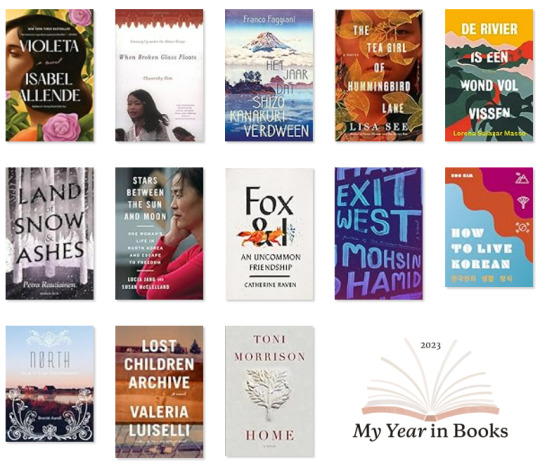
My Year in Books 2023:
9,563 pages read
33 books read
Home by Toni Morrison
- historical fiction, race, trauma, family
- set in US (Georgia), Korea (Korean War) in 1950s
- main characters: Frank Money, Ysidra “Cee” Money
Lost Children Archive by Valeria Luiselli
- fiction, family, immigration, deportation
- set in US (New York to New Mexico/Arizona)
- main characters: unnamed mother, father and their two children
North: How to Live Scandinavian by Brontë Aurell
- nonfiction, lifestyle, culture
- set in Denmark, Norway, Sweden
Fox and I by Catherine Raven
- nonfiction, memoir, nature, environment, biology
- set in US (Montana)
How to Live Korean by Soo Kim
- nonfiction, lifestyle, culture
- set in South Korea
Exit West by Mohsin Hamid
- fiction, romance, dystopia, war, immigration
- set in Middle East, Greece (Mykonos), UK (London), US (San Francisco)
- main characters: Saeed, Nadia
Stars Between the Sun and Moon: One Woman’s Life in North Korea and Escape to Freedom by Lucia Jang
- nonfiction, memoir, oppression, survival
- set in North Korea, China in 1990s
Land of Snow and Ashes by Petra Rautiainen
- historical fiction, World War II, Sámi, mystery
- set in northern Finland in 1944, 1947-1950
- main characters: Inkeri Lindqvist, Olavi Heiskanen, Väinö Remes
This Wound Full of Fish by Lorena Salazar Masso
- fiction, motherhood
- set in Colombia (Atrato river)
- main characters: unnamed mother, unnamed boy, Gina
Kings of the Yukon: An Alaskan River Journey by Adam Weymouth
- nonfiction, nature, environment, memoir
- set in Yukon, Alaska
The Tea Girl of Hummingbird Lane by Lisa See
- historical fiction, family, tea, Akha culture, adoption
- set in China (Yunnan), US (California) between 1980-2016
- main characters: Li-yan, Haley Davis
Il guardiano della collina dei ciliegi (The Year Shizo Kanakuri Disappeared) by Franco Faggiani
- historical fiction, sports, solitude
- set in Japan, Sweden between 1900s en 1960s
- main character: Shizo Kanakuri
When Broken Glass Floats: Growing Up Under the Khmer Rouge by Chanrithy Him
- nonfiction, memoir, war, survival
- set in Cambodia in the 1970s
Violeta by Isabel Allende
- historical fiction, family saga
- set in Chile, US between 1920-2020
- main characters: Violeta del Valle, Camilo del Valle
The Year of Magical Thinking by Joan Didion
- nonfiction, memoir, grief, loss
- set in US (NY and LA)
Butcher’s Crossing by John Williams
- historical fiction, western, nature, bison hunt
- set in US (Kansas, Colorado) in 1870
- main characters: Will Andrews, Miller, Charley Hoge, Fred Schneider
The Unseen (De usynlige) by Roy Jacobsen
- historical fiction, family saga, hardship
- set in northern Norway between 1910-1930
- main character: Ingrid Barrøy
White Shadow (Hvitt hav) by Roy Jacobsen
- historical fiction, family saga, hardship
- set in northern Norway in 1940s
- main character: Ingrid Barrøy
The Wind Knows My Name by Isabel Allende
- historical fiction, immigration, war
- set in Austria (Vienna), US (Arizona), El Salvador between 1938-2019
- main characters: Samuel Adler, Anita Díaz, Selena Dúran, Leticia Cordero
The Devil’s Highway: A True Story by Luis Alberto Urrea
- nonfiction, immigration, crime
- set on the Mexican/US border (Arizona)
Braiding Sweetgrass by Robin Wall Kimmerer
- nonfiction, indigenous, nature, environment
- set in North America
Hearing Birds Fly by Louisa Waugh
- nonfiction, memoir, travel, culture
- set in Mongolia (Tsengel) in late 1990s
Betty by Tiffany McDaniel
- historical fiction, family saga, coming-of-age, loss, abuse
- set in US (Ohio) between 1900s-1970s
- main character: Betty Carpenter
To the Lighthouse by Virginia Woolf
- fiction, classic, modernism
- set in UK (Scotland) in 1920s
- main characters: Mrs Ramsay, Mr Ramsay, Lily Briscoe
Tracks: One Woman's Journey Across 1,700 Miles of Australian Outback by Robyn Davidson
- nonfiction, memoir, adventure, nature
- set in Australia in late 1970s
The Ethnic Cleansing of Palestine by Ilan Pappé
- nonfiction, history, politics, war
- set in Palestine (Israel) in 1880s-1940s
Train to Tibet (De trein naar Tibet) by Maja Wolny
- nonfiction, travel, culture
- set in Russia, China
Sovietistan by Erika Fatland
- nonfiction, travel, culture, history
- set in Turkmenistan, Kazakhstan, Tajikistan, Kyrgyzstan, Uzbekistan
The Travelling Cat Chronicles by Hiro Arikawa
- fiction, family, grief, cats
- set in Japan
- main characters: Nana the cat, Satoru Miyawaki
Before the Coffee Gets Cold by Toshikazu Kawaguchi
- fiction, magical realism, time travel, loss
- set in Japan
- main characters: Kazu Tokita, Kei Tokita, Nagare Tokita, Yaeko Hirai
Tales from the Café: Before the Coffee Gets Cold by Toshikazu Kawaguchi
- fiction, magical realism, time travel, loss
- set in Japan
- main characters: Kazu Tokita, Nagare Tokita, Miki Tokita
The Road by Cormac McCarthy
- fiction, sci-fi, dystopia, humanity
- set in US
- main characters: a father and his son
Educated by Tara Westover
- nonfiction, memoir, family, religion
- set in US (Idaho)
1 note
·
View note
Text
Health & safety & death in the workplace : 2004 : BBC World Service Trust, Phnom Penh
We were standing in a concert hall designed like a futuristic room on the ‘Discovery One’ spaceship in the film ‘2001’. Every feature was brilliant white. White plastic seats. White walls. White ceiling. When the house lights were switched on, it was a dazzling sight. In 1968, my father had accompanied me to watch that sci-fi movie at our local cinema because my school project concerned the American space race. Simultaneously, maybe an unknown architect somewhere had exited a theatre, sufficiently inspired by Stanley Kubrick’s cinematic vision to design their next project, this room, all-white.
The huge hall appeared little used and surprisingly intact, despite the sprawling two-story concrete headquarters of ‘Radio National Kampuchea’ [RNK] in which it was built exhibiting significant evidence of the raging civil war that had started with the overthrow of Cambodia leader Prince Norodom Sihanouk in March 1970. I wondered to myself whether this concert hall had served as a secret location for the Khmer Rouge leadership to enjoy a Friday night knees-up after a hard week’s work torturing and murdering fellow citizens. There might be ghosts here that would be best undisturbed.
“You will be training our staff here,” ordered Tan Yan, RNK director general, waving his hand around the cavernous hall.
“Er …,” I replied, on the verge of telling him that this was no suitable venue to train a handful of his staff in radio production. But I managed to restrain myself from contradicting this Cambodia government appointee. I recalled that, only months prior, Chour Chetharith – deputy editor of an independent Phnom Penh radio station ‘Ta Prohm 90.5 FM’ critical of the country’s ruling party – had been shot dead by two gunmen on a motorbike on arrival at his workplace. Like anybody, I would like to live.
From his instruction to me, it was evident that our host likely had never made a radio programme, had scant idea how radio programmes were produced and had never needed to learn. His role, in charge of the government’s one national radio channel, was to ensure that its output caused no problems for his masters. We had just come from an initial meeting in his office, a cramped room awash with paper and lacking any twentieth century technology other than a telephone and an electric fan, but weirdly reminiscent of a North London taxi cab office. Then he had shepherded our delegation into a long narrow room, empty apart from two lines of chairs on opposing walls. Speeches were made in Khmer by government men sat opposite. My BBC colleague said something in English. We all stood up, uncomfortably close together in that small sweaty space, a photograph was taken and printed in the following day’s newspaper, trumpeting the first partnership between the Cambodia government and the BBC to produce radio programmes.
After the concert hall, our guided tour of the radio station took us to a large windowless office crammed with desks piled high with papers and occupied by scribbling staff. Our host explained that this was the nerve centre of his operation where everything had to be ‘checked’. Strangely, there were no signs of radio production equipment. The sign on the office door said ‘CENSORS’. This is where every script written by lowly radio employees was edited by important managers to ensure the words’ suitability for broadcast to the nation. Then it was recorded onto analogue tape in an unseen studio somewhere, to be returned here for checking that the announcer had not inserted any personal inflection or inference into their reading of the approved script. Every item within the station’s output was created this way. Not one minute of ‘live’ content had ever been transmitted. If aliens were to invade, this radio would inform Cambodians a week after their abduction to a distant galaxy.
We were then taken to a large darkened room in the bowels of the building, filled with standalone metal shelf units on which the station’s tape archives were stored. Thousands of items were evident, many in boxes, some not, much seemingly uncatalogued, some unspooling all over the floor. It was an unholy mess. No air conditioning. No organisation. But it was surprising it had survived at all the Khmer Rouge era. Right here, since the station’s launch in 1947 under the supervision of the Ministry of Propaganda, we were told there were priceless recordings of musicians, interviews and news reports spanning the country’s turbulent history … if you could ever find them amongst the chaos. I was awestruck.
Then it was down to work. The BBC had requested interviews with a dozen of RNK’s existing staff, from which we would choose a radio production team whom I would train to create (shock horror!) a live weekly phone-in programme, the first in the station’s history. We decamped to one of several unused rooms whose doors had been removed and that opened onto the compound, where we sat around a group of old desks pushed together in the middle. No air conditioning. Just a bare room and the three of us: the BBC’s radio manager in Cambodia, Chas Hamilton; BBC translator Keo Sothearith; and freelance me. We had a list of staff names and that was all. No CV’s. No idea who we were about to see.
One by one, our candidates arrived and what ensued was the most bizarre round of interviews I have ever encountered. Asked what their present job entailed, what skills they possessed and what they wanted to achieve in their career, most failed to answer anything at all. Some just stared at us as if we were mad. Several answered “I do what my boss tells me”. None appeared enthusiastic about their work or the potential of training with the BBC. Reluctance would be a gross understatement. I wondered to myself how they had secured their jobs in radio in the first place if their communication ‘skills’ were so poor. They seemed to consider our polite enquiries as interrogation, as if we might incarcerate them for any incorrect answer … or worse. Perhaps the government radio station staff were still being managed through ‘fear’, just as the Khmer Rouge had terrorised the population not so long ago.
By the time we reached our last interviewee, we had noticed that all our candidates had been dressed in black. We asked why. Our last man explained that one of their female colleagues at the station had recently been killed by falling masonry from the crumbling war-torn building, so the staff would be attending the funeral that afternoon. We looked at each other open-mouthed. We were sitting in a death trap. Oh dear! What were we doing there? Despite me having interviewed potential candidates for radio jobs in many countries, this selection proved the most difficult to assess because we had elicited almost no relevant information. We remained there a while afterwards to discuss our preferences, deciding to select the marginally least reticent six staff and hope for the best. I felt anxious about how I could train people who appeared so disinterested.
Our morning’s work done, we left the room and headed to the director’s office to thank him and say goodbye. It was empty. We walked out to the front gates of the compound and were astonished to find them locked from the outside. We walked back to the building and wandered around offices on the two floors, shouting ‘hello’. It was completely deserted. Like their former colonial masters, the staff must have left en masse at precisely midday and would not return for two hours. We had been locked in without anyone anticipating that their morning visitors might still be present.
All the three of us could do was walk through foliage around the inside of the high perimeter zinc fence and look for a gap to escape. Eventually we did find a small hole where the metal had suffered damage, we prised it open and, bending down, could just about crawl through. By then, we had been outdoors in the midday sun for a while and, once returned to the BBC office, we desperately needed refreshment. It was a bizarre end to a bizarre morning of meetings at the government radio station.
That afternoon, after reflecting upon our experience, I told my local line manager, Chas Hamilton, and the BBC Cambodia project manager, Giselle Portenier, that I considered the RNK premises a wholly unsuitable venue for me to train staff. Was there a room in the BBC building I could use instead? The local staff showed me a conference room with a boardroom table that seemed ideal. I almost fainted when I realised I had seen this exact space, with its large circular motif embedded in the marble floor, during a dream five years earlier. Not for the first time, ‘déjà vu’ sneaks up out of nowhere to surprise you in the strangest situations.
To me, it seemed self-evident that this room – in a secure, air-conditioned environment with access to a kitchen and toilet facilities – was the perfect solution to hold my training sessions two full days each week for the next few months. I was taken aback to be told that neither Hamilton (who had visited RNK with me) nor Portenier (who had not) agreed. Apparently, the BBC’s contract with the government insisted the training would take place on-site at RNK and that was considered the end of it. Before making that agreement, had anyone from the BBC actually visited the RNK building? This stalemate lasted more than a month. Maddeningly, in January the BBC in London had sent me to Cambodia to start work with the utmost urgency and yet, by March, I was still unable to commence training one of my two radio production teams.
In desperation, I felt forced to send this formal email on 30 March to Hamilton and Portenier:
“I feel I should flag that no specific resolution has yet been agreed to the health and safety issue of the RNK building.
After my visit to RNK on 2 March 2004, I immediately expressed my concern (verbally) to Charles and Giselle about the health and safety risk of undertaking training work at the RNK premises. In subsequent conversations with Charles, Giselle and Lori [McDougall], possible remedies were discussed that involved training RNK staff off-site.
Paragraph 10(5)(a) of the WST [BBC World Service Trust] Freelance Terms Of Trade requires the Freelance to “make an assessment of all risks to health and safety reasonably foreseeable by him/her that may affect the WST or any others arising out of or in any way connected with the performance of the Contract” and to “promptly make and give effect to arrangements to eliminate or adequately control such risks.” The Freelance is made responsible for health and safety issues.
The Freelance is obliged to “notify the WST accordingly,” which I have done (verbally), and I will reiterate (in writing) my assessment: The RNK building is in a terrible state of repair and looks as though it has not been maintained for at least a decade, maybe longer. Most exterior windows have no glass and many of the rooms no longer have doors. Only a few rooms seem to have air conditioning. We learnt that a member of staff has recently been killed by masonry falling from the building. There is little or no visible security, and the large front reception area within the building is completely empty. When we went to leave the premises at noon, we found all exit gates were padlocked, and the building devoid of any staff to assist. We eventually found an exit through a gap in a zinc fence to the rear of the building. We have yet to see any kind of refreshment facility, or inspect the toilet facilities.
I do not feel that this is a safe environment in which to spend several days a week training RNK staff. Such training could be arranged off-site without any loss of relevant radio facilities (since RNK has no live studio/production environment relevant to the training). As you are aware, I suggested that training could instead be conducted at the BBC office and/or ‘FM 102’ (or elsewhere).
I am sure that we can work together to resolve this issue and commence the training of RNK staff.”
Still enduring no local approval, I then had to write a similar email to the BBC office in London which resulted in further queries, more correspondence but, eventually, grudging acceptance that my work could be undertaken in the conference room only metres away from my office desk. The outcome was that training sessions which should have started in January did not commence until April, by which time the plan had been for me to return home. However, having just won such a frustratingly minor victory, I felt it would have been irresponsible to leave immediately, so I offered to extend my time in Cambodia a further few months. Nonetheless, the RNK phone-in programme had still not launched by the time I eventually left, sadly as a direct result of these delays attributable to the BBC. This was the first time I had been employed by the BBC, as well as my first work for an international charity, and my experience with ex-pat managers had proven far from productive.
By contrast, my training sessions in the BBC conference office with the RNK staff, about whom we had harboured such initial doubts, proved to be amazingly positive. They were wonderful people who taught me as much about Cambodia as I hopefully taught them about radio. I was so sad to leave them without having seen through their phone-in programme, which finally launched on-air in October.
I never returned to the RNK building. However, I did run into the station’s director at the press launch of some health project in Phnom Penh that the BBC insisted I attend. We stood together in silence in the garden of the venue, a small high circular table between us on which we placed our free drinks. Conversation was impossible. My knowledge of French proved irrelevant because the language had been effectively extinguished by Khmer Rouge assassinations of anyone vaguely academic in the 1970’s. This middle-aged government man smiled at me friendlily, though I found myself wondering what ‘successes’ he might have achieved in Year Zero to have sufficiently impressed the ruling party.
Once back in London, I wrote an email to UNESCO explaining that I had viewed RNK’s broadcast archives and believed they should be preserved, catalogued and stored in an improved environment because of their historical significance not only to Cambodia, but globally. No reply. I tried my best!
I had had a job to do … flying to Cambodia.
#BBC#Cambodia#career#Grant Goddard#radio#radio broadcasting#radio industry#Radio National Kampuchea#radio sector#radio station#travel
0 notes
Text
Week 9 - Body Modification & The Impact it Carries
The purposeful altering of one's body for aesthetic, cultural, or personal purposes is referred to as body modification. There are several ways it might manifest itself, such as through tattoos, piercings, scarification, branding, implants, and more. The effects of body alteration are complex and might differ based on personal circumstances and cultural situations.
Self-Expression
Body alteration is frequently viewed as a tool for people to express themselves, establish their identities, or communicate personal meanings. It enables people to express their connections, views, and values graphically and may be a source of empowerment, self-awareness, and self-assurance.
Human bodies have always been objects of alteration, purposefully marked and reshaped in various ways and for varied reasons (Brain, 1979; Caplan 2000). As opposed to current cosmetic surgery, which typically aims to give the appearance of "natural" beauty, such interventions were typically used throughout much of history to distinguish the changed from the natural body in obvious and palpable ways (Henley & Porath 2020). Sometimes these changes were imposed on persons against their choice as retaliation, punishment, or stigmatisation (Henley & Porath 2020). More frequently, they were voluntary actions designed to shield their bearers from danger of various types, mark rites of passage dividing stages in a person's life, or distinguish persons of status and fame (Henley & Porath 2020). These historical bodily changes frequently also appear to have been the result of an aesthetic drive, particularly in the instance of tattooing (Henley & Porath 2020).
Cultural Significance
Many civilizations have strong historical and cultural origins in the practise of body alteration. Within particular groups or subcultures, they may have important cultural, spiritual, or ceremonial significance. For instance, in some cultures, tattoos or particular piercings may represent group allegiances, rites of passage, or social rank.
Prior to the introduction of Westernising reforms at the turn of the 20th century, Thailand used tattoos for administrative purposes and to denote both noble and slave rank (Reid, 1988, pp. 77–78; Terwiel, 1979, pp. 156–160). The holy or magical tattooing traditions, in which religious scriptures and symbols are interwoven into charms written on the body to protect its owner against disaster, are still supported or tolerated by Thai, Burmese, Lao, and Khmer Buddhism today (Cummings & White 2012). Many current Burmese, Thai, and Laotian borderlanders still have intentionally stained or otherwise altered teeth. Many young Thai males still conduct penile alteration, at least among lower socioeconomic classes (Thomson et al. 2008).
Psychological and Emotional Impact
Individuals may have psychological and emotional repercussions from changing their bodies. Self-esteem, bodily satisfaction, and a feeling of personal empowerment may all increase for some people. Others may use body alteration to show their uniqueness, reclaim their bodies, or deal with trauma. For instance, getting a butterfly tattoo on your body may represent freedom, significant change, and tremendous prospects, which might inspire the person receiving the tattoo to feel more optimistic and hopeful about her own development. It's important to understand that not everyone will have a pleasant experience, and some people may struggle, regret, or feel unsatisfied with their changes.
Brain, R., 1979. The decorated body. Hutchinson Radius.
Caplan, J. ed., 2021. Written on the body: The tattoo in European and American history. Princeton University Press.
Cummings, J. and White, D., 2012. Sacred tattoos of Thailand: exploring the magic, masters and mystery of sak yan. (No Title).
Henley, D & Porath, N 2020, ‘Body modification in East Asia: History and debates’, Asian Studies Review, vol. 45, no. 2, pp. 198–216.
Reid, A., 1990. Southeast Asia in the age of commerce, 1450-1680: Volume one: The lands below the winds. Yale Univ Pr.
Terwiel, B.J., 1979. Tattooing in Thailand's history1. Journal of the Royal Asiatic Society, 111(2), pp.156-166.
Thomson, N, Sutcliffe, CG, Sirirojn, B, Sintupat, K, Aramrattana, A, Samuels, A & Celentano, DD 2008, ‘Penile modification in young Thai men: Risk environments, procedures and widespread implications for HIV and sexually transmitted infections’, Sexually Transmitted Infections, vol. 84, no. 3, pp. 195–197.
0 notes
Text
Bangkok and Beyond

Happy Fall,
Despite being in one of the biggest, most populated cities I have ever been in my life, I was serenaded to sleep by a chorus of frogs last night. Torrential rains flooded the streets in Bangkok yesterday & our trip home on the boat from the weekend market was quite the wild adventure. We did fine on the metro, though it's a bit too air-conditioned for my taste. Rather like whizzing along in a super smooth refrigerator car. Just installed in the last 15 years, new metro stops are still being created, a bit of a wacky miracle in such a gigantic city.

We just barely squeezed onto the local boat taxi, packed in like sardines. I almost lost John in the fray. A woman who got on beside me at the next stop, was pushing me so hard that I thought I was going to fall over & break everything in my shopping bag. Finally< I traded places with her & became suddenly aware of why she was trying so hard to get further inside the boat. Within seconds, approximately a bucket of water came off of the roof tarp and poured right down my back. I was more soaked than the front seat of Splash Mountain, but fortunately my pirate booty from the market stayed dry. Mostly it has just been a little bit of rain now and again, beautifully cooling when we get it.
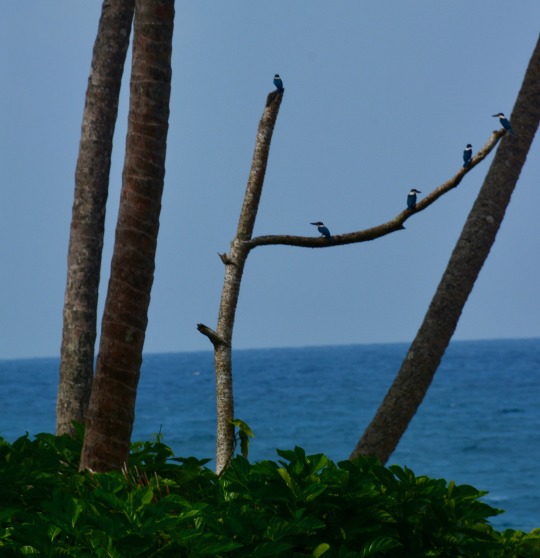
We have been amazingly lucky to have an opportunity to see a Healer here in town, who is very famous within Thailand, but virtually unknown to the western world. Like my massage practice, his healing is known mainly by word-of-mouth. They say you have to have the right Karma to come see him, so I must' have done something right at some point. The healing takes about five minutes, but the taxi ride there is anywhere from 45 minutes to 2 and 1/2 hours. Then we have to get back, creating quite a full day. Fridays are easy because the turnaround time is quite good, but on Sundays when we go & wait in line with the locals, it'''''' is usually a few hours in the healing center. We are the only "flongs," foreigners, aside from our translator, a wonderful Aussie buddhist who has been here for nearly 40 years. We receive our sessions from an esoteric buddhist healer who lived as a hermit monk in a sacred jungle cave for ten years, until he was called to heal people. I feel like that is such an amazing amount of time to be silent & still. I cannot quite imagine the wisdom that one might procure from such a practice✨

His father was very familiar with the healing properties of the jungle herbs so each week we boil some to make a tea.The first one was for detoxification of the kidneys, second for cleansing the blood and then one that helps the ligaments & sinews. He treats the seven primary diseases in the first sessions, including cancer, diabetes, fatty liver disease, heart issues, and arthritis.There is a monk who lives in a temple next door to the healing center who, after being diagnosed with stage 4 cancer got treatments and he looks great.

We had a quiet week off the coast of Sumatra for John to go surfing. A beautiful island with shy monkeys and amazing kingfishers. Back to the mainland of Sumatra, a few days in the rainforest for me to see orangutans & for them to see me. We camped in the jungle for two nights, hiking straight up then straight down muddy, steep terrain. We saw some giant colorful hornbills, Thomas monkeys (my favorite new nickname for John on that trip), monitor lizards, something that looked like an iguana & a plethora of other beautiful birds. What a wonderful gift to get out of the city.
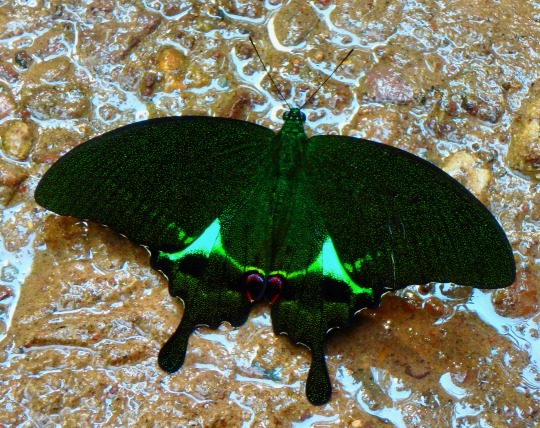
Upon our return to Thailand, we also spent a few days near the bridge over the river Kwai. Peaceful and beautiful, with a great old third class train ride 3 hours north of Bangkok.I believe it took us about 1&1/2 hours to get out of the city to the countryside & occasionally pass beautiful pools of giant lotuses.
A bit exhausted from our treatments, we spent the last week in the Bangkok visiting the Jim Thompson house, the weekend market & some other local sites. Great to get some Christmas shopping done so early.
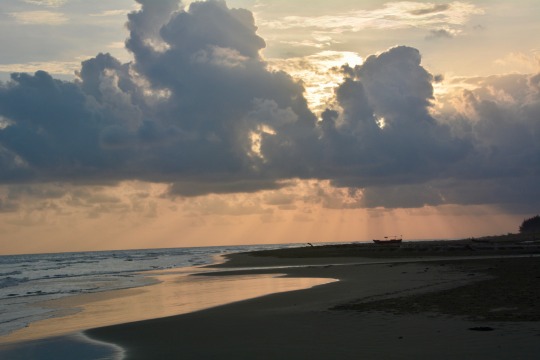
Yesterday was our six year anniversary & we were lucky enough to get a very special Saturday “Prosperity treatment,” in between our normal routine. We dressed all in white, had special symbols called yans written in red ink on our backs, each side of our hands, and right on the hairline in the center of the foreheads. The treatment clears karma from past lifetimes & creates good fortune for the future. We asked weeks in advance for this treatment & I feel very lucky to have been able to receive it. The healer had one word after he wrote on us both & that was "clear," oh joy. I thought how wonderful & auspicious to have this fall on our anniversary. I felt so light & joyful afterwards & slept better than I have in forever. Today we are back for our Sunday treatments & tomorrow we will head north until Thursday to see the nature park, Khao Yai. If we are lucky, we will get to see elephants.
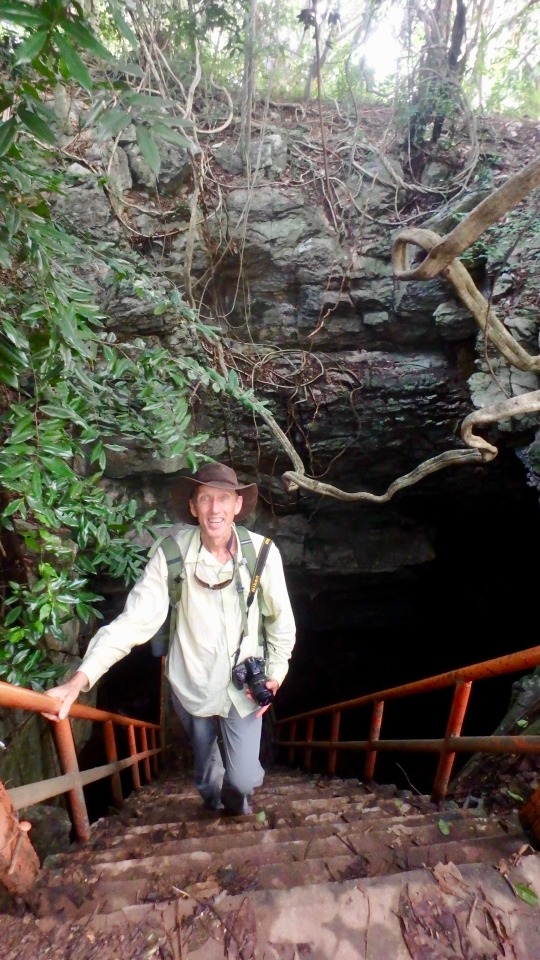
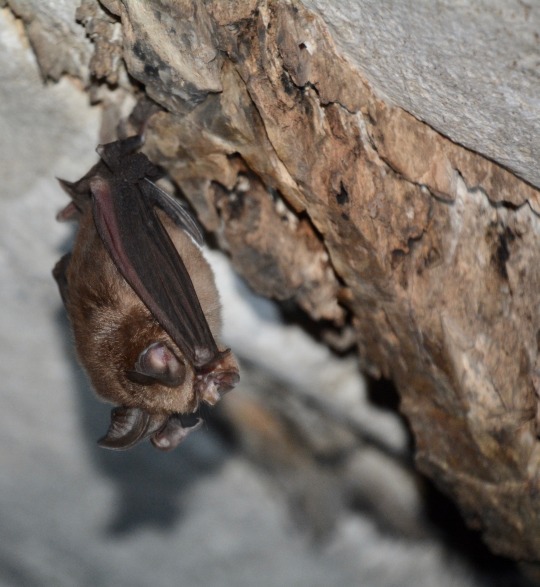
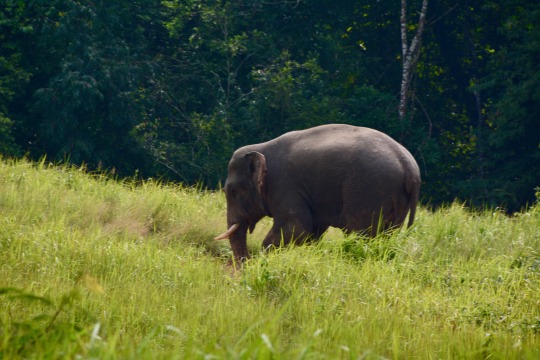
October Footnote: I have once again been delinquent in sending this & more time has passed.During our Bangkok visit we had an amazing & magical trip to Khao Yai with so many animals & insects, also a hot & beautiful trip up to the old Thai capitol, Aytthaya, visiting some ancient khmer style buddhist temples, and more down time in the city as those healings can really take it out of you. I think of it as a sort of fast forward healing from which one has to detox and catch up with oneself again.

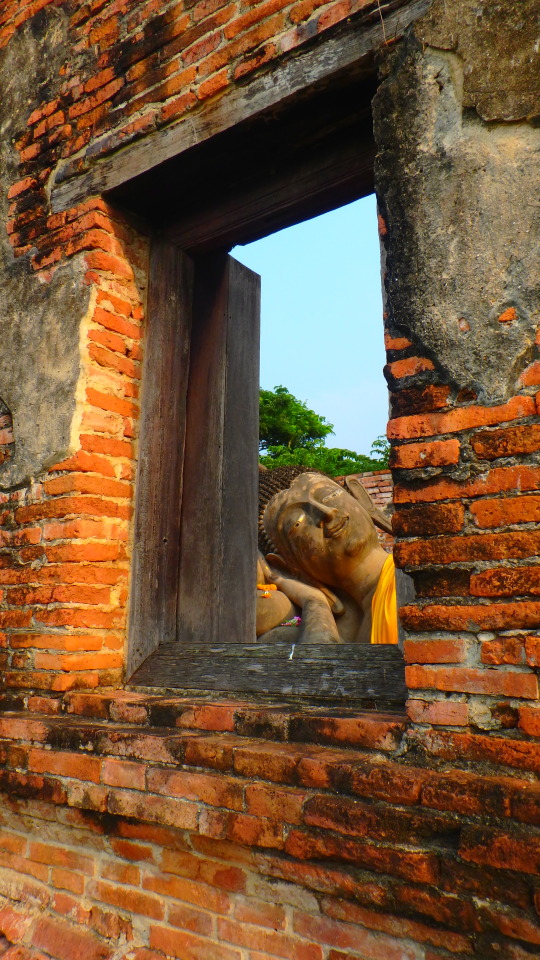
We have finished our last treatments & travelled to a small beach community in southwest Java where I will get to relax at the beach & see tiny sea turtles released from a local hatchery. John hopefully will enjoy the surf.
Miss you and hope that life is lovely, healthy and joyous, Ahna-Kristen

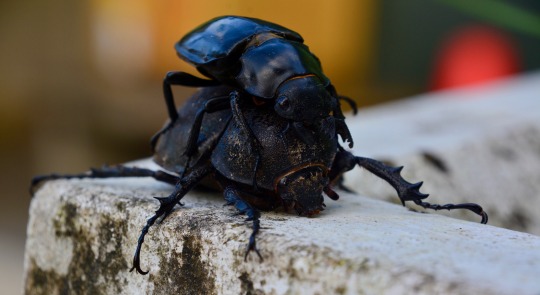
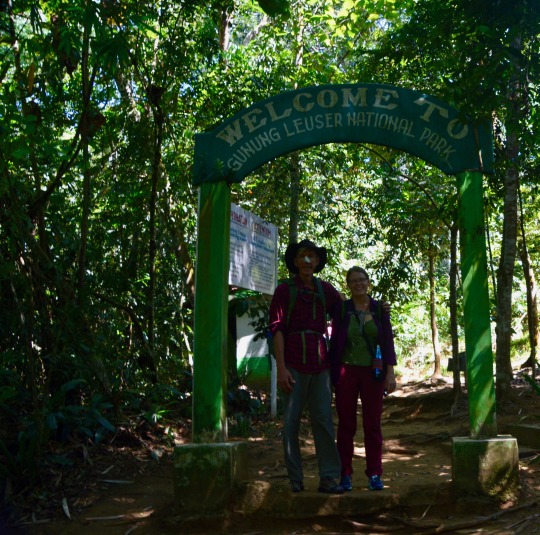
HI EVERYONE,
Ahna-Kristen and I have been gone a month now. We were invited to go see a healer in Bangkok by one of her clients. The healer only sees people on Friday thru Sundays, and we go twice a week. On Fridays we get a body treatment and a facial treatment. On Sundays we get another body treatment. Fridays are super slow and there is usually no one there, or just a couple of other people, then on Sundays there are around twenty people and they have a big pot of food out for everyone to share. For each treatment we leave an offering of flowers incense, candles, these little coins and some money that we place in an envelope. Treatments are by donation only, so everyone gives what they can afford. About 98 percent of the people that see him are Thai, so very few white people go there and that makes us a bit of an oddity. We would be lost without the valuable help of our interpreter Jimmy, a 75 year old Aussie man who has lived in Southeast Asia for the last 45 years. We are staying in a hotel that is half a block for his apartment and he arranges a cab to take us the hour drive out to the treatment center. He interprets everything the healer tells us. During a treatment Anchon opens a point near my solar plexus and then lightly rubs his finger across my body. In some areas it creates extreme pain and feels like his finger is made of steel and on other areas I barely feel it at all. He is working with meridians, points and blocked energy.
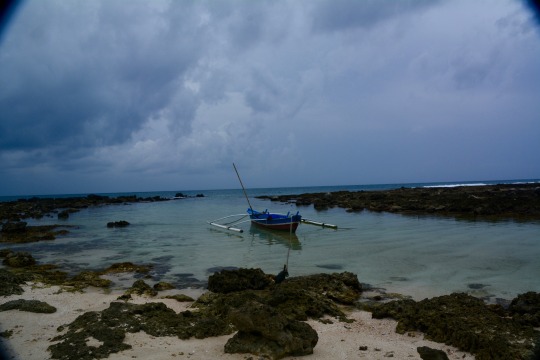
As the story goes, he was a hermit monk and lived in a cave for more than ten years when celestial beings started to visit him and train him to become a healer. He said no initially, as he did not want to leave his life of solitude. They started writing on the walls of his cave, leaving him messages and teachings on how to heal people. After some time, he agreed to become a healer.
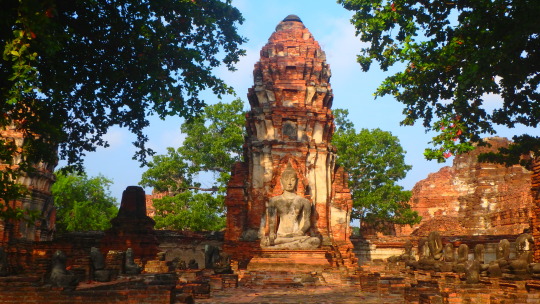
Our original plan was to see him once when we arrived, then go surfing in Indonesia for a month and come back and see him twice on the way home. After our first treatment, he told us if we came to him for a month he would send both of us back home healthy. So we decided to stay on after the surf trip. After our first treatment, we flew to Simelue, an island off of Northern Sumatra.
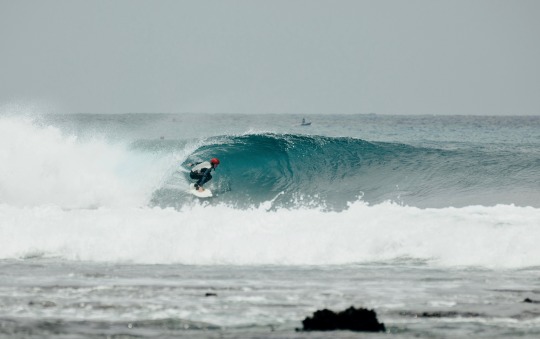
On my first surf paddling out I did a face plant on the lava reef while trying to duck dive a wave. Our surf trip was cut short by my accident, which took about three week for my face to heal from. This was a sign for me that I was supposed to head back for more healings. I had prepaid the surf lodge where we were staying and they where super generous, lettimg me postpone the rest of my paid stay for a week in September. That gave us six days before we could have our next treatment.
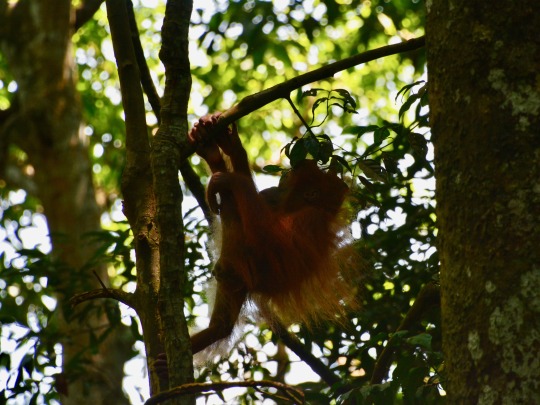
We headed up to Buket lawang to do a three day jungle hike to see the orangutangs and other creatures that live in the rainforest,
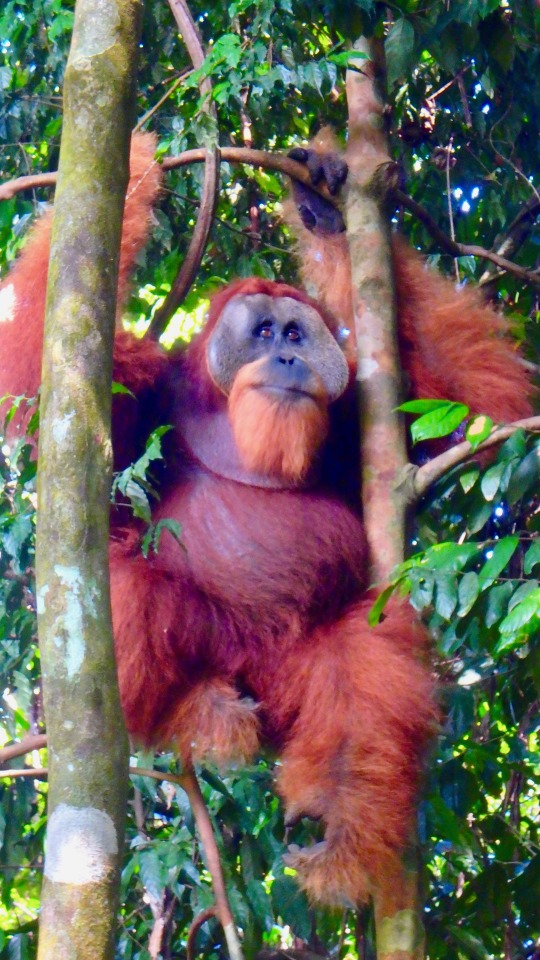
before flying back to Bangkok. We have now seen him 5 times, and are on a 12 day break back in Simelue enjoying the beach life, warm water and the quite. We will be going back to Thailand for another 4 weekends of treatment. Spending so much time in a big city like Bangkok makes me so grateful for my home in Aptos.
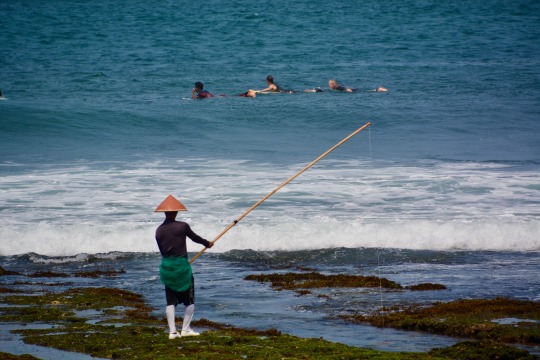
Well a month has passed and we are leaving for home in a few hours after spending two weeks in West Java surfing and relaxing at the beach. I had a lot of fun surf and feel really good after spending the 6 weeks with the healer. I am looking forward to being home and reconnecting with you all.

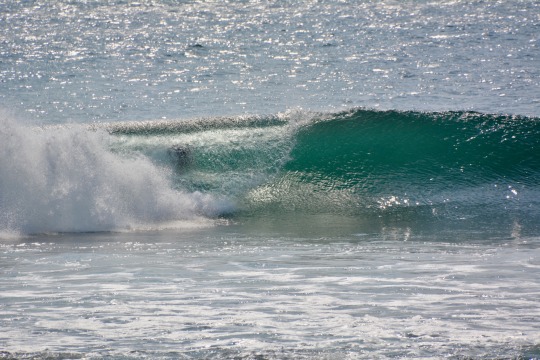
Love to you all,
John

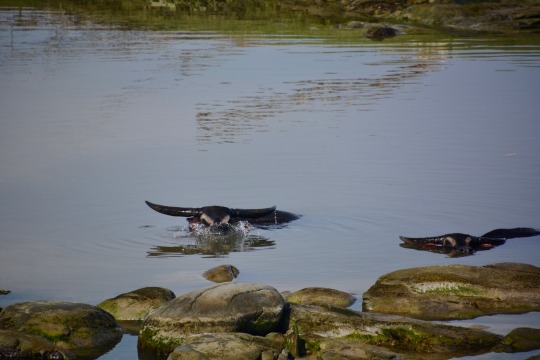

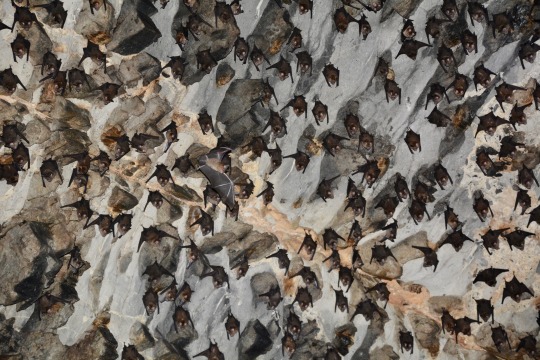
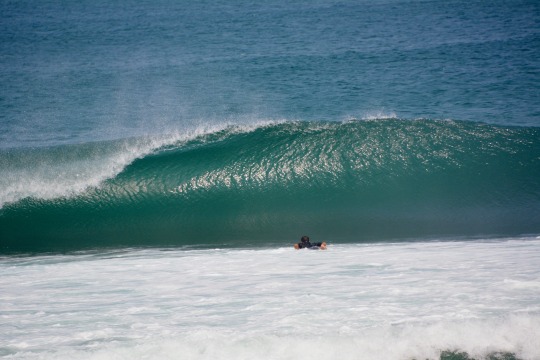

1 note
·
View note
Text
a list of words that mean “white person” or “white people” in as many languages as possible
please feel free to reblog with any other words you might know, or correct any mistakes
Dakota : wasi'chu
Lakota : wasi'chu
Nasa Yuwe (paez) : mushka
Namtrik (misak, guambiano) : pølelø
Kabyle, Chaoui (Amazigh languages) : rumi, rumiya, irumiyen
Egyptian Arabic : khawag, khawagi, khawaga
Algerian Arabic : gawri, gawriya, gwer
Moroccan Arabic : nasrani
Hassaniya : nasrani
Mooré : nasara
Pulaar (peul) : toubakou
Wolof : toubab
Malinke : toubab
Medumba : mekat, bah mekat
Yoruba : oyibo
Akan (Ashanti Twi, Akuapem Twi et Fante) : oburoni, obroni
Anyi (Brosa, Aowin) : brofo, brofwe
Ga : blofo, blofonyo
Ewe : yovo
Fon (Fon-gbe) : yovo
Mina (Gen, Gen-gbe) : yovo
Lingala : mondele, mundele, mindele
Tswana : lekgoa
Somali : cadaan
Amharic : frenji
Tigrinya : tseadu, tseada
Swahili : mzungu, wazungu
Shikomori : mzungu, wazungu
Luganda : muzungu, bazungu
Chichewa : muzungu, azungu
Chinyanja : muzungu, bazungu
Kinyarwanda : umuzungu, abazungu
Kirundi : umuzungu, abazungu
Bemba : musungu, basungu
Kisii : omusongo, abasongo
Sena : muzungu, azungu
Shona : murungu, varungu
Xhosa : umlungu
Sisiwati : umlungu
Ndebele : umlungu
Zulu : umlungu, abelungu
Malagasy : vazaha
Mauritian Creole : zorey, zoreille
Reunionese Creole : zorey, zoreille
Martiniquan Creole : béké, bétché, bétcha, zorey
Guadeloupean Creole : béké
Noongar : wadjela
Cook Islands Maori : papa'a
Maori : pakeha
Niuean : palagi
Samoan : palagi, papaalagi
Tongan : palangi, papaalangi
Fijian : vavalangi
Hawaiian : haole
Urdu : gora, gori
Hindi : gora, gori
Tamul : வெள்ளைக்காரர் vellaikaarar, வெள்ளைக்காரி vellaikaari, வெள்ளைக்காரன் vellaikaaran, வெள்ளைக்காரர்கள் vellaikaarargal
Thaï : farang
Khmer : barang
Indonesian : bule, totok
Vietnamese : mỹ trắng
Cantonese : 鬼佬 gweilo, gwailou, 死鬼佬 sei gwailou, 鬼仔 gwaijai, 鬼妹 gwaimui, 鬼婆 gwaipo, 白鬼 baakgwai, 西人 sai yan, 洋人 yeung yan
Mandarin : 白人 bairen, 白种人 baizhongren, 老外 laowai, 洋鬼子 Yang guizi Japonese : 白人 haku jin
Dari : safed, safeda
Turkish : beyaz
Greek : aspro
Rromni : gadjo, gadji, gadjé
Romanian : alb
Polish : biały
Slovak : bielý
German : weiß
Dutch : wit, witte mensen
Flemish : blank
Italian : bianco, bianca, bianchi
Portuguese : branco, branca, os brancos
Spanish : blanco, blanca, los blancos, blanco-mestizo, gringo, güero, mono, gabacho, bolillo, guait, guaitero, guaitera
French : blanc, blanche, les blancs, babtou, les babtous
English : white, whitey, white people, wypeepoo, cracker, mayo
#White People#whypipo#wypipo#whitepeople#white#wipipo#mayo#babtou#languages#language#indigenous languages#African Languages#asian languages#langblr#blancs#blanc
52 notes
·
View notes
Note
good afternon do you know any brown or tan skinned southeast asian full blooded actresses preferably khmer age range between 20-27 years old ?
Hello there consider the following! Resources will vary for each fc.
Cambodian/Part Cambodian Fcs (1989-1999)
Tharoth Sam (1990)
Lida Duch (1991)
Marline Yan (1993)- Also parts Chinese, Indian, Thai, and Vietnamese
Angelina Chung (1993)
Source/Another Place to Check Out
Tasksweekly number: 97 Cambodia -please note I didn’t look into the actresses with unknown ages
0 notes
Text
40 years on, Khmer Rouge leaders face genocide verdict | News
Phnom Penh, Cambodia – Vang Tam, 65, is in little doubt over what he would do if he ever encountered the Khmer Rouge accountable for the demise of his mother and father and 4 siblings within the 1970s.
“Even when I died, I’d take his head off. I would do no matter,” he shouts, dragging on a cigarette inside his floating house on Cambodia’s Tonle Sap river.
“Our ancestors have been executed close to the mountains, I used to be the one one not killed.”
Tam is an ethnic Vietnamese fisherman who was born in Cambodia. Like a whole lot of 1000’s of others, he was evacuated to Vietnam quickly after the Maoists beneath Pol Pot took management of Cambodia, however a lot of his household stayed behind.
When he returned house in 1980, after the Vietnamese had overthrown the Khmer Rouge, he found about 40 of his household have been useless.
Those that hadn’t been executed had died from overwork or hunger.
On Friday, the Extraordinary Chambers within the Courts of Cambodia (ECCC), higher referred to as the Khmer Rouge Tribunal, will hand down its verdict on whether or not the regime’s “Brother Quantity Two,” Nuon Chea, 92, and its head of state, Khieu Samphan, 87, dedicated genocide towards ethnic Vietnamese and Cham Muslims, one other minority.
Former Khmer Rouge head of state Khieu Samphan on display within the media centre on the Khmer Rouge Tribunal [Pring Samrang/Reuters]
Judges may even rule on whether or not the 2 males are responsible of crimes towards humanity associated to prisons, worksites, pressured marriages and sexual violence.
The courtroom sentenced each males to life phrases in 2014 for crimes towards humanity for his or her position within the pressured evacuation of cities quickly after the Khmer Rouge took energy.
Accountability
Friday’s resolution comes with the tribunal going through widespread criticism for prolonged delays, authorities interference, and corruption.
Whereas some argue the courtroom has delivered long-awaited justice for victims, others have labelled the method a waste of money and time with convictions towards solely three folks in 12 years.
Opinion was break up amongst Cham and ethnic Vietnamese survivors of the regime interviewed by Al Jazeera. Many know nothing in regards to the tribunal.
Sa Rom Ly, 62, a Cham who managed to outlive mass purges in Kampong Cham by pretending he was ethnically Khmer, mentioned he was certain the Khmer Rouge tried to wipe out his folks – one thing prosecutors have been trying to show.
“The Khmer Rouge wished to eliminate Cham due to our faith,” he mentioned, including he supported the tribunal.
“We’re blissful that the ECCC held a trial of the senior leaders of the Khmer Rouge as a result of it could assist maintain them accountable for his or her actions,” he mentioned.
“They should be punished as a result of they have been those who ordered the regional chiefs to execute folks and so they adopted their orders. If not, they’d be killed too.”
Speaking after prayers at a mosque in Phnom Penh’s Russei Keo district, Kop Math, 64, recounted comparable brutality meted out to Chams in Battambang after they’d been evacuated from the capital.
“My father sneaked away to wish however they noticed him and took him away to be killed,” mentioned Math, who misplaced 16 of his 20 shut members of the family.
Math, who visited the tribunal twice throughout the genocide phase, mentioned he believed the courtroom was delivering true justice to the victims, however he wished to see extra folks within the dock.
“I believe they need to convey regional commanders to justice … however we do not need the decrease ranges. If we demand [the lower levels] to be dropped at justice this might end in confrontation,” he mentioned.
Kop Math sits exterior a mosque in Phnom Penh [George Wright/Al Jazeera]
In search of justice
Down a winding alley that runs alongside the Mekong River, El Los, 72, defined how he misplaced all his mother and father and siblings after being informed they’d been taken away on a ship and executed in Kampong Cham.
Los mentioned he knew nothing of the tribunal however that every one Khmer Rouge, from prime to backside, must be made to pay for his or her crimes.
“We actually need to discover justice however the place are they? We’re struggling however what can we do?” he mentioned. “The decrease ranges level and say they have been following orders – however all must be held accountable.”
Prime Minister Hun Sen, a former Khmer Rouge commander who helped overthrow Pol Pot after defecting to Vietnam, has been vocal in his opposition to additional trials, claiming it might plunge Cambodia again into civil struggle.
Cambodia’s courtroom upholds Khmer Rouge life sentences
Each Cambodian and worldwide judges sit within the courtroom and either side must agree on choices. Native judges and prosecutors have been accused of being beneath the affect of the federal government, particularly in ongoing investigations of mid-ranking former Khmer Rouge.
The actual fact such a small quantity from the regime have been dropped at justice is a standard frustration amongst many Cham survivors, defined Farina So, principal deputy director of the Documentation Middle of Cambodia and creator of The Hijab of Cambodia.
The Cham researcher mentioned though the tribunal – notably the genocide case – was vital to many Cham, creating public boards for dialogue between victims and perpetrators and their kids was very important in serving to communities reconcile.
“It is also efficient as a result of it’s worthwhile to get issues out of the courtroom and into the group. Then they’ll talk about overtly with out worry,” So mentioned.
‘Only a present’
Again on the Tonle Sap river, barely any of the 15 ethnic Vietnamese interviewed mentioned they knew in regards to the tribunal.
“No person talks about it. I don’t know what this courtroom is,” mentioned Chroeng Yan, whose father was clubbed to demise by a Khmer Rouge soldier.
Vang Tam, one of many few who was conscious of the courtroom, was scathing in his evaluation.
“It is only a present, it is meaningless,” he mentioned.
His good friend sitting subsequent to him, Veeng Thhan Yoeng, 65, interjected.
“About 40 of my family have been killed… I do not assume we are able to get justice,” he mentioned. “We need to see extra on trial.”
!function(f,b,e,v,n,t,s)(window, document,'script','//connect.facebook.net/en_US/fbevents.js');
fbq('init', '968100353246427'); fbq('track', 'PageView');
from SpicyNBAChili.com http://spicymoviechili.spicynbachili.com/40-years-on-khmer-rouge-leaders-face-genocide-verdict-news/
0 notes
Photo

In the Mood for Love (2000, Hong Kong)
Nearing the turn of the twentieth century and with the final holdouts of colonialism being freed, Western audiences could not separate Chinese-language cinema from their perceptions of period costumes and stirring action. One director born in Shanghai but raised in Hong Kong – whether he was considering Western attitudes or not – aimed directly at those expectations with Days of Being Wild (1990) and Chungking Express (1994). That director is Wong Kar-wai, and his In the Mood for Love (it should be noted this is only second film of his that I have seen, so this write-up may be deprived of comparative auteuristic commentary) has since become a staple of international cinema for a new millennium. Certainly, there are burdens and benefits alike of being labeled as an international classic – such recognition allows a film to be more widely seen, but sociocultural nuances tend to be lost on those further away from the concerns and settings of these films.
That distance was something I struggled with throughout almost all of In the Mood for Love’s ninety-eight minutes of romantic drama (and am continuing to grapple with). Despite these personal labors, In the Mood for Love has an exquisite delicacy to its artistry – from central actors Maggie Cheung and Tony Leung, its production design, the camerawork, and even its diegetic music and soundtrack including Peking and Cantonese opera – but the film’s use of Nat King Cole (a favorite of Wong’s mother) singing Latin music is most notable.
It is 1962 in Hong Kong and two Shanghainese transplants – journalist/creative writer Chow Mo-wan (Leung) and secretary Su Li-zhen (Cheung) – find themselves to be neighbors in a tenement building located within a neighborhood populated by Shanghainese immigrants (cultural and linguistic differences between the Shanghainese and the Cantonese-speaking Hong Kongers assured that both groups had minimal contact with the other). They are both married, as their respective spouses are away from home most hours of the day. Lunches and dinners alone become routine. Eventually, Chow and Su get together, share stories, and realize that their respective spouses are engaged in an affair with each other. Coincidences of infidelity be damned, a friendship forms due to nuptial neglect. But this is a romantic drama, so of course feelings develop as Chow and Su realize the incredible irony of their mutual attraction.
This is what it must have been like for our spouses, Su observes. “Feelings can creep up just like that. I thought I was in control,” Chow muses.
Their spouses are never depicted and any romantic inklings are kept to dialogue and close-up and medium-length shots of the two actors gazing at each other. In the cinema of other directors and other nations, romance can be a sweaty, sordid thing. For Wong – as he accomplished in Days of Being Wild – sensuousness is achieved by his two characters realizing that they will be no better than their respective spouses if they consummate rather than just collaborate. In the Mood for Love is a more sexually repressed piece than Days of Being Wild and, somehow, the former is the more romantic, arguably more erotic, experience. Both rely on hushed tones, but In the Mood for Love restrains itself from even private displays of affection. Days of Being Wild’s greens and rainy-day grays are substituted for In the Mood for Love’s glaring yellow streetlights, lamplights, and interiors and its red curtains. Su’s collection of qipao – almost all of them adorned in warm colors – manage to increase the sexual tension with those high collars and flowered patterns. It is difficult to recall another film that so directs its emotional contours through costuming; credit costume designer William Chang (who also co-produced, edited, and designed the film’s sets) for his keen eye.
Wong – who also produced and wrote In the Mood for Love – occasionally leads his central characters to plot developments that might appear arbitrary and too impeccably timed. Some of these less believable moments include Chow’s invitation to Su to assist him in completing his martial arts serial for his publication and the penultimate flash-forward. These screenwriting decisions should have buckled and battered an otherwise beautifully-crafted film. To some degree of rescue, it is the two central performances that sell these moments. Also starring in Days of Being Wild ten years earlier, Cheung – who plays a different character here with the same name from that past role – required several hours of makeup and costuming before shooting. In this film, Cheung, like her costar, must be disarming yet muted. She carries herself with elegance for the entire production, and a scene where she is suggestively walking upstairs while Leung is walking downstairs is astonishing physical acting. In another era, in another film, such a scene might have been considered shallow, scandalous; here, it only emphasizes how unintentional her character’s connection to Leung’s is. For Leung, he embodies a man’s inclinations to human interaction without realizing or mentioning the immediate significance or basic point of such relationships – no matter the length of acquaintance. His head is somewhere in the clouds, lost to disappointment and to the realization of being in the mood for love but refusing – like Cheung – to do much about it.
Delays in production – Cheung and Leung mostly improvised their lines as the screenplay only provided direction, not dialogue; a protracted Asian financial crisis also factored – forced cinematographer Christopher Doyle (Days of Being Wild, Chungking Express) to depart the film midway through, being replaced Mark Lee Ping Bin (a favorite of Taiwanese director Hou Hsiao-hsien, perhaps most notably for 2015′s The Assassin). Both Doyle and Lee are afforded credits, and it is unclear – at least, from the literature I have gleamed (I get this funny feeling the Criterion release has extras material that would be relevant) – which cinematographer shot certain scenes. Shooting on-site mostly in Bangkok alongside Hong Kong, Doyle and Lee place their cameras low to the ground, around street corners, beneath the surfaces of desks and dinner tables, and through open doors and windowsills. As characters walk from one destination to the next, the camera floats along, keeping a distance neither intrusive nor distant – always within reasonable earshot. The effect is a little voyeuristic, never violating. Perhaps, here, it is apt to consider that Wong initially wanted to call this film Secrets (he backtracked, believing too many films already had “secrets” in their title... he settled on In the Mood for Love after listening to Bryan Ferry’s “I’m in the Mood for Love”). Chow and Su’s clandestine friendship is provided further mystique by the cinematography, in addition to the film’s palette.
Doyle and Lee’s use of space heightens awareness of empty spaces – spaces where a spouse, a group of friends might otherwise occupy. Instead, Chow and Su’s world of loneliness is a byproduct of a sort of disownment, of unbelonging. There are few better places reflective of that imbalance than Hong Kong: a place where West and East intermingle, where mainlanders and Hong Kongers self-segregate, where love goes to be lost as well as found.
This is where William Chang’s art direction stars, but most especially the film’s soundtrack. Only a handful of non-musical films can boast a soundtrack – which is distinct from a film’s score – that can enliven the atmosphere and gift the setting a quality belying the artifice of cinema sets. For various reasons that should be explained elsewhere, modern filmmakers are gravitating towards non-original soundtracks over original scores (something that grates yours truly, but I digress), and In the Mood for Love’s use of various songs – from Nat King Cole’s versions of “Quizás, Quizás, Quizás”, “Aquellos Ojos Verdes”, and “Te Quiero Dijiste” and songs like “Shuang Shuang Yan” by Deng Bai Ying – reflect Hong Kong’s cultural influences and sometimes the moods of the central characters (In the Mood for Love could be described as a mood piece). Never overwhelming the sound mix, these songs were the soundtrack for a previous generation of Hong Kongers, and their presence here is autobiographical, heartfelt.
The final scene of In the Mood for Love was shot at Angkor Wat in Cambodia in the film’s only nod to historical events. Originally a Hindu temple, later converted to a Buddhist temple, and on the route connecting India to Southeast Asia and China, Angkor Wat would be largely untouched by two future events – the carnage of American intervention in the Vietnam War and the Khmer Rouge’s genocide. It, too, became a cultural crossroads. In the Mood for Love aspires to a similar timelessness. In mumbles and secretive whispers into darkened corners, In the Mood for Love captures an impossible romance committed to its characters’ desires and motivations. Time – from the film’s setting and the year of its release – appears not to have diminished the passions kept within.
My rating: 10/10
^ Based on my personal imdb rating. In the Mood for Love is the one hundred and thirty-ninth film I have rated a ten on imdb.
#In the Mood for Love#Wong Kar Wai#Maggie Cheung#Tony Leung#Christopher Doyle#Mark Lee Ping Bin#William Chang#Michael Galasso#Shigeru Umebayashi#Siu Ping Lam#Rebecca Pan#Lai Chen#Nat King Cole#TCM#My Movie Odyssey
5 notes
·
View notes
Text
Repressively 3
repressibility \ ri-ˌpre-sə-ˈbi-lə-tē \ noun. repressible \ ri-ˈpre-sə-bəl \ adjective. repressive \ ri-ˈpre-siv \ adjective. repressively adverb.
repressively - Traduzione del vocabolo e dei suoi composti, e discussioni del forum.
dict.cc English-German Dictionary: Translation for repressively.
ENGLISH KHMER DICTIONARY - LEARN ENGLISH FAST.
Answers for behave repressively (5,4,2) crossword clue. Search for crossword clues found in the Daily Celebrity, NY Times, Daily Mirror, Telegraph and major ...
repressively meaning in Hindi:: ADV दमनकारी ढंग से …. click for more detailed Hindi translation, definition, pronunciation and example sentences.
Unscramble letters REPRESSIVELY with minimum score 10.
Jan 19, 2006 - MZF1 possesses a repressively regulatory function in ERCC1 expression. Yan QW(1), Reed E, Zhong XS, Thornton K, Guo Y, Yu JJ.
Repressively Meaning in Urdu is جبراً - Jabran Urdu Meaning. The most accurate translation of Repressively, Jabran in English to Urdu dictionary with Definition ...
Looking for the definition of REPRESSIVELY? Find out what is the full meaning of REPRESSIVELY on Abbreviations.com! The Web's largest and most ...
Accordingly, I suggest, the child overcomes splitting by withdrawing from involvement, by repressively containing its feelings for the caregiver. Just as we, as ...
repressively coupled gene regulatory oscillator networks. Yongqiang Wang, Senior Member, IEEE, Yutaka Hori, Shinji Hara, Fellow, IEEE, Francis J. Doyle III, ...
What rhymes with repressively? Lookup it up at Rhymes.net - the most comprehensive rhyming words dictionary on the web!
Intercellular delay regulates the collective period of repressively coupled gene regulatory oscillator networks. Yongqiang Wang, Yutaka Hori, Shinji Hara, ...
Participants initially completed a measure of their dispositional tendency to interpret suffering repressively (i.e., as an indication of personal deviance and need ...
Download Citation | Intercellular Delay Regulates the Collective Period of Repressively Coupled Gene Regulatory Oscillator Networks | Most biological rhythms ...
repressively çevirisi anlamı nedir nasıl telaffuz ediliz.
repressive | repressively [adverb, derived]. acting to control, suppress, or restrain | subjecting people, a society, etc, to a state of subjugation (16 of 411 words, ...
repressilator · repressing · repression · repression (psychology) · repression-sensitization · repressively · repressiveness · repressor · repressor gene · repressor ...
0 notes
Text
Samsung, iPhone, Xiaomi ve Huawei Batarya Değişimi
iPhone Batarya Değişimi, Sony M2 ekran değişim fiyatı 200 TL.Huawei kullanarak the art profesyonel ekipman ve tamir cihazları alanında uzman teknisyenlerimiz ile teknik servis tamir ve onarım Bölümü 2 saat yoğun 30 dakika değerli müşterilerimize teslim edilir günlük işimiz göre değişim işlemleri görüntüler. Firmamızda yaptığımız tüm ekran değişiklikleri 6 ay yedek parça ve işçilik için garanti edilmektedir. Sony ekranı değiştirirken en sağlıklı ve en uzun ömürlü olan %100 orijinal ekranı kullanıyoruz.
Samsung Batarya Değişimi, Orijinal ekran değişiklikleri uzun vadede en başarılı yöntemdir. Sony ekran değişikliklerinde kullandığımız tüm ekran yedek parça ürünleri piyasada orijinal olarak kabul edilen Orijinal kalite ekranlarından oluşur ve tüm kontroller sözleşmeli orijinal cep telefonu yedek parça toptancıları tarafından yapılır. Sony Screen exchange işleminden sonra teknik servis ekibimiz cep telefonunuzun ekran dokunmatik ve parlaklık testlerini tamamlar ve yeni ekrana ücretsiz Sony Screen Saver unbreakable glass ekler ve cihazınızı size teslim ederiz. Sony XPERİA M2 kamera değişimi Sony XPERİA M2 cep telefonumuzun en önemli özelliklerinden biridir.
Huawei Batarya Değişimi, Akıllı telefonlardaki kameralar kullanıcılar için çok önemli bir yer tutuyor.Özellikle gemide aile olsun cektiğimiz arkadaşlar olsun cektiğimiz. okul hayatımızda ya da cep telefonu kameralarımızda olsun çok önemlidir.Cep telefonu ön ve arka Khmer tamemen bağımsız olarak çalışıyor. Genel kamera arızaları çarpmadan sonra meydana gelen kırık ile bulanık ve kısmi çekimlerdir bunların dışında kameranın kamera ekranındaki arızasının bir sonucu olarak ortaya çıkan yazılım arızalarıdır. Herhangi bir etki söz konusu değilse öncelikle sorunun yazılımdan mı yoksa kameranın kendisinden mi kaynaklanacağı daha sonra belirlenmelidir konuyla ilgili yazılım güncellemesi sıfırlanmalı veya ön kamera değiştirilmelidir.
Xiaomi Batarya Değişimi, Kamera değişiklikleri aynı gün yapılabilir ve bu süre parça tedarik süreci nedeniyle uzatılabilir. Kamera değişimi 6 ay garantili bir tufan iletişimi olarak gerçekleştirilir. Sony XPERİA M2 arka kapak değişimi Sony arka kapak değişimi: Mağazamız cep telefonlarımızı günlük hayatımızda kullandığımız talihsiz kazaların bir sonucu olarak Kırılan arka kapakları değiştirir.Ürünlerimiz kesinlikle orijinal ve bizim mağaza yan renk atmak ve benzer hataları ortaya çıkar sorunları sonucunda 6 ay garanti sağlar. Sony XPERİA M2 cep telefonu hoparlör tamir cep telefonu sorunları en yaygın ses sorunları başında.
0 notes
Video
Kun Khmer, Sor Reachsey Vs Yaw Yan Naing Moe, (Myanmar), CNC boxing, 21 ...
0 notes
Text
Bún ba khía, bún kèn – món ăn lạ mà quen ở vùng sông nước miền Tây
Những món ăn đặc thù vùng sông nước miền Tây như bún ba khía, bún kèn vô cùng lạ miệng nhưng khôn cùng quyến rũ thực khách.
Bún ba khía
Ba khía họ cua, khác một tẹo về dạng hình và trên lưng mang 3 gạch (khía) buộc phải người dân miền Tây gọi là ba khía. Trước đây ba khía muối là món ăn của người nghèo nhưng hiện tại đã trở nên món khoái khẩu, đặc sản mà phổ biến người tới đây thích thú.
Để bắt ba khía, trước đây vào ngày rằm tháng 10 âm lịch, người dân ven biển miền Tây đem thau, hòm... cộng đèn đuốc đi soi ba khía bắt cặp từng chùm trên những cây bần, cây mắm. Để thu hoạch nhiều, người ta sử dụng tay với bao da gạt hoặc lấy rổ cào chúng vô vật cất. Giờ ba khía ngày càng hi hữu, để bắt được cũng mất công hơn.
Bún ba khía lạ mà quen của ẩm thực miền Tây. Ảnh: I.T
Thường thì ba khía ở Cà Mau, Bạc Liêu sẽ ngon hơn cả bởi hương vị đằm thắm, giết thơm ngon. Sở hữu siêu nhiều bí quyết chế biến ba khía như nướng, rang me, luộc nước dừa ba khía muối... Nhưng đã đến đây, bạn khăng khăng thử món bún ba khía dân dã, lạ mà quen của người dân sông nước.
Món ăn này có hai vật liệu là bún tươi và ba khía hấp nước dừa ăn cùng nước mắm chua ngọt. Lúc dùng, người ta xé nhỏ ba khía rồi trộn đều mang đường cát, ớt, tỏi, mì chính, nước chanh để nâng cao vị ngọt. Đây là một món ăn với đậm bản chất vùng miền, mộc mạc nhưng ko kém phần quyến rũ.
Bún kèn
Bún kèn - mẫu tên nghe lạ gợi trí tò mò là đặc sản của Châu Đốc, An Giang hoặc Nên Thơ. Mặc dù ko nhiều khách du lịch biết món ăn này nhưng nếu tới đây bạn đây, cố định buộc phải thử món bún lạ miệng này. Vật liệu để nấu bún kèn gồm nước cốt dừa, thịt cá, ngũ vị hương, bột điều, sả, nghệ... phải bí quyết chế biến cũng cầu kỳ hơn bún ba khía.
Bún kèn - món ăn dân dã ở miền Tây. Ảnh: Yan
Gọi là bún kèn bởi mang người cho rằng “kèn” trong tiếng Khmer dùng để ám chỉ những món ăn với sử dụng nước cốt dừa. Mỗi nơi mang 1 phương pháp chế biến nước lèo (nước lèo) khác nhau nhưng căn bản được nấu từ các mẫu cá ngân, cá biển...
Cá được xay nhuyễn rồi sở hữu đem xào mang sả, ớt, tỏi… xào đến khi cá khô và thơm giòn, giữ được vị bùi và đượm đà, thơm ngon. Sau ấy cho nước cốt dừa, nước cá luộc đã lọc bỏ xương... rồi nêm nếm gia vị, nấu cho đến lúc nước sền sền. Gia vị khăng khăng cần sở hữu bột cà ri hoặc ngũ vị hương, nước cốt dừa. Khi ăn, món bún với vị thanh thanh, tươi mát, để lại các hương vị khó quên.
Theo danviet
Nguồn: Ẩm thực 365
Xem bài nguyên mẫu tại :
Bún ba khía, bún kèn – món ăn lạ mà quen ở vùng sông nước miền Tây
0 notes
Photo

Yan Jing Beer - FOOD NIGHT - China Trip #flashback #china #beijing #guangzhou #mrmab #rito #ritz #ritokaizen #khmer #travel #traveling #food #guijie #yanjing (at 簋街(鬼街))
#beijing#mrmab#ritz#food#ritokaizen#guangzhou#khmer#guijie#rito#yanjing#china#traveling#flashback#travel
0 notes